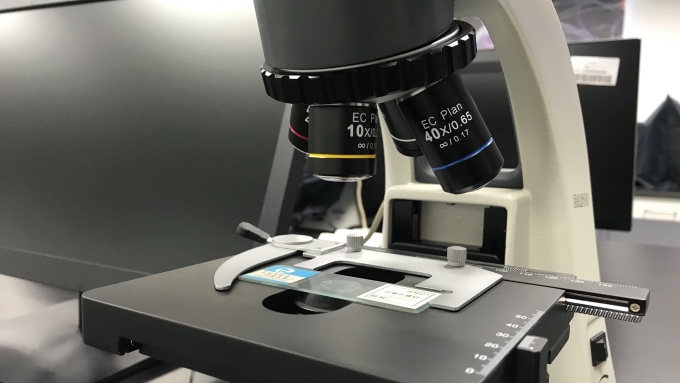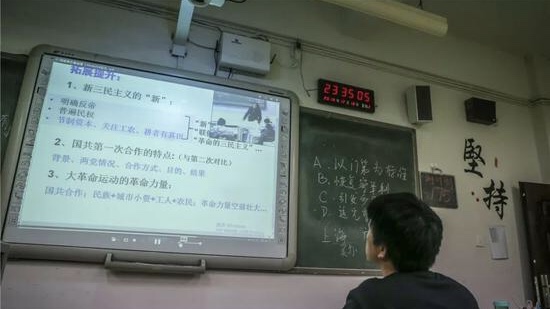Livestreaming education has helped students in China’s rural areas gain access to top resources, could it be a solution to narrow China’s urban-rural educational gap?
In a classroom of Leibo high school, the curtains are drawn. Dim light and stagnant air of summer make student sleepy. Sometimes, a teacher knocks the corner of table for reminding the yawning student. The depressed atmosphere is filled with a cacophony of sound from the projector which is simultaneously broadcasting the English class of the Chengdu No 7 High School, one of the best high schools in the nation.
When the enthusiastic teacher of Chengdu No.7 High School asks questions, the students there actively engage in the interaction. However, at the room of Leibo high school, students are just silent. “We are all attending the same lecture. However, when staring at the screen, we are spectators rather than participants,” said 16-year-old Zhang Xuan, a senior-one student in Leibo high school.
Chengdu No. 7 High School has begun to share high-quality educational resources through the livestreaming courses since 2004. Over the past 15 years, 72,000 students from approximately 250 high schools in China’s poverty-stricken areas have attended livestreaming classes, finished homework and exams simultaneously with Chengdu No. 7 High School.

The progress can be seen. More than 80 participants were admitted to China’s top 2 universities, Tsinghua University and Peking University. The majority of students who attended distance courses were able to be enrolled to undergraduate education, according to official statistics from East Edu which is the third-party company who provides technological support and platform for this distance learning project[1]. “For part of schools, the undergraduate enrolment rates has increased more than ten times,” said Wang Hong, the head of East Edu.
Figures seems to be in consistent with the initial purpose of the project. Sharing educational resources, live broadcasting courses are to help more remote students experience the quality education. Annually, the acceptance rate of first-tier universities in Chengdu No.7 High School exceeds 90%. More than 30 students were admitted by well-known overseas universities such as National University of Singapore. Approximately 80 students were admitted to China’s top 2 universities.
On the other side, Leibo high school, as one of China’s high schools in poverty-stricken areas, before cooperating with Chengdu’s No. 7 High School in 2004, students who were able to enter first-tier universities were below ten. Despite Leibo High School was set up in 1944, it did not nurture the first student to Tsinghua University until 2014. “Without such livestreaming teaching model, we could not imagine that our school can send students to Tsinghua University,” said Xu Hua, the principal of Leibo High School.
The educational gap between these two sides is remarkable. When these two groups of students study together, distance students cannot keep up with Chengdu’s learning progress at the beginning. “I was so bad,” said Zhang Xuan. During one-hour conversation, she repeated the sentence six times. She is the best senior-one student in Leibo and has attended the livestreaming courses for almost half year. But in this mid-term exam, she took test papers of Chengdu No.7 High School, approximately failed all subjects.

During English lesson, Chengdu teachers often play TED video or American movie. Sometimes, they invite native English teacher to deliver speeches. For students in Leibo, they are confused. “I cannot understand what they are saying. I feel I am too useless,” said Zhang Xuan. She spent half an hour on answering five reading questions conducted by Chengdu No.7 High School. The whole article was filled with her careful notes of new words, unfamiliar phrases, run-on sentences. However, finally, all her answers were wrong.
Every year, only 60 students in Leibo High School can truly adapt to Chengdu’s fast-paced, well-rounded education, among the top 200 freshmen who have the chance to participate in livestreaming courses. “More than 80% participants have cried. Only those who could face the harsh reality and get used to it could benefit from the distant learning,” said Xu Hua, the principal of Leibo High school.
Some students have to choose to quit the livestreaming courses and back to the local school’s original education mode. Luo Qianyu, a student in Yibin High School which also cooperates with Chengdu’s school, had been qualified to enter the livestreaming class but he quitted after a-year distant education. “I even did not know what questions I should ask when the lecture was over. I am still used to the test-oriented education based on textbooks, rote learning, repeated practices. I have tried but I still cannot keep up,” he said.
The outcome of remote education varies and even become polarized. At the beginning, in Leibo High School, the highest score in livestreaming class was 520 and the lowest was 480. After three years’, top students might reach more than 600 but bottom students are still 480.
As a result, livestreaming education seems to solve an unfair education problem while it has created a new unfairness. Cheng Fengchun, professor from faculty of education in Beijing Normal University, said. “When we are happy for the achievement that a small group of students have achieved, it is also worth noticing that the pattern of “key urban schools” “key elite class” dominance has enhanced. The essence is still prioritizing a certain group of people,” he added.

There are two types of high schools in China, namely key-point high school in urban areas and ordinary high school largely in counties. The education quality of key-point high school outweighs ordinary high schools thoroughly. The problem of uneven distribution of educational resources between urban and less developed areas has deep historical roots in China.
Since the reform and opening up in 1980s, the Ministry of Education promoted the construction of key schools. The initial purpose is that key high schools would be able to pool resources and explore teaching experience, then gradually promoted to ordinary high schools. However, the result is different. “Key high schools have monopolized quality teachers and students,” said Prof. Cheng. Even supporters of the “key school” system admit the imbalance caused by it. However, they think it is still a way to make the most use of educational resources for nurturing national elites.
Chengdu No.7 High School is listed as one of China’s leading high schools. Walking around the campus, sounds of piano and Ukraine spread from music classroom. Two huge French windows of the teaching building sticks with colourful posters. They are the admission information of overseas students, the competition of Tsinghua University and the notice of an independent music magazine. Students are allowed to use iPad and iPhone to take notes throughout the lecture. During the lunch break, students gather in the cafe on the terrace and talk about their favourite directors, the latest Marvel movie.

All these things are unfamiliar to students in counties. They hit children as well as stimulate children. Wang Qin, principal of Yibin High School, believes the most powerful impact of distance learning is on expanding students’ horizon. He said, “These students need to see what things looks like in the outside world. This might be the best teacher to stimulate them. To some extent, livestreaming courses can fill the gap of horizons.”
Such thought has been proved by Luo Qianyu, the student who quitted the livestreaming class. “I would say quitting Chengdu’s distance education is my life’s mistake,” he said. After he went to Beijing for college, he got aware of the importance of horizon. When his college students talk about clothes brand, electronical products, Luo Qianyu could just keep silent. “At that time, I could not stand the huge pressure of attending livestreaming courses. However, now I think pressure should work as the stimulus.Actually, as a person born in township, I am bound to be hit by the social imbalance. Earlier is better than later,” he said.
Students who choose to study with Chengdu’s school do obtain concepts and knowledge beyond textbooks. Wu Nan, as a student who used to study in Yibin High School and attend Chengdu’s livestreaming courses throughout the three-year high school, he was admitted by Tsinghua University in 2017. He said, “If I didn’t take livestreaming courses, I won’t hear the current news broadcast on the screen, appreciate poetry, understand different political systems and be exposed to different thinking patterns.”
However, owing all achievements to the livestreaming course seems unfair. “The screen gives students’ unrealistic illusions. They gradually ignored other effectual factors,” said Prof. Cheng.
The Chinese government has launched a preferential policy in disadvantaged areas since 2012. It requires top universities to increase their quota and lower the admission grade in designated more than 800 stricken-poverty counties. In 2018, the policy benefitted more than 100,000 students in target areas to enter first-tier universities, according to the statistics from The Ministry of Education[2]. “It is unrealistic that attributing all the improvement in disadvantaged schools to the digital education. The national policy is effective,” said Mei Hong, the researcher of Public Policy in Xian Jiaotong University.
Digital education is not a new thing for China. Actually, since 1978, China has tried to develop television, broadcast distance education but at that time the improvement is quite modest. Now, the universalisation of Internet has boomed China’s online education market. In 2018, the evaluated value to the market has reached £29.27 billion (251.76 billion RMB), an increase of 25.7% over the same period last year[3], according to statistics from one of China’s largest business consulting company, iResearch. However, these patterns are all regarded as the supplement to traditional education. Livestreaming mode totally replaces local schooling and students’ academic activities are all together with Chengdu’s School.
Actually, teachers in counties still play an essential role in students’ learning process. When Zhang Xuan, the senior-one student in Leibo high school, cried and felt depressed. Her English teacher, Yu Meng who has been working here more than five years, comforted her a lot. Additionally, Yu Meng helped students understand those difficult pointes during the livestreaming class. “Teachers in Chengdu will not know the reaction of our side and they will not accommodate our progress. Thanks to local teachers, they help us digest knowledge,” Zhang Xuan said.
The pressure of local teachers is also high. Yu Meng attended every livestreaming class with students and listened carefully. For answering students’ questions effectively, she needs to grasp all the essentials as much and quicker as she can. “The lecture of Chengdu’s school is advanced for students and they have no opportunities to communicate with those teachers. We need to take the responsibility,” said Yu Meng.
Yu Meng supported such remote education. “I also regard it as a school for me. We, teachers in less developed areas, lack the opportunity of receiving high-quality training. Teachers’ in Chengdu improved me a lot as well,” said Yu Meng.
However, not every local teacher thinks in Yu Meng’s way. Some teachers in counties feel they are undermined and are unwilling to participate actively in. A number of teachers even protested by tearing up textbooks, according to report from News China[4]. A certain percentage of teachers do not take the weekly training provided by Chengdu’s school seriously, according to the feedback from principal of Chengdu No.7 School. “Teachers really matter the urban-rural education inequality. The key thing should be the improvement of teachers’ quality in rural areas,” said the researcher, Mei Hong.
China still has a long way to go for improving educational equality. Technology is just a tool not a solution. “The thing is not simply technology changes children’s life chances. In terms of how to help more students involve in quality educational system, we still need to reflect from the root of imbalance and seek for actual solutions,” Prof. Cheng said.
Zhang Xuan is still hoping the livestreaming
class could help her dream come true. She has lived in the mountainous Leibo
county for 16 years. “I have never seen the sea. I hope I can be admitted by a
coastal university, warm and beautiful,” she said, and looked out of the
window.
[1] http://www.eastedu.com/aboutus.html
[2] http://www.sohu.com/a/288175822_260616
[3] https://www.jiemodui.com/N/104434.html
[4] http://www.newschinamag.com/newschina/articleDetail.do?article_id=4914§ion_id=17&magazine_id=39

